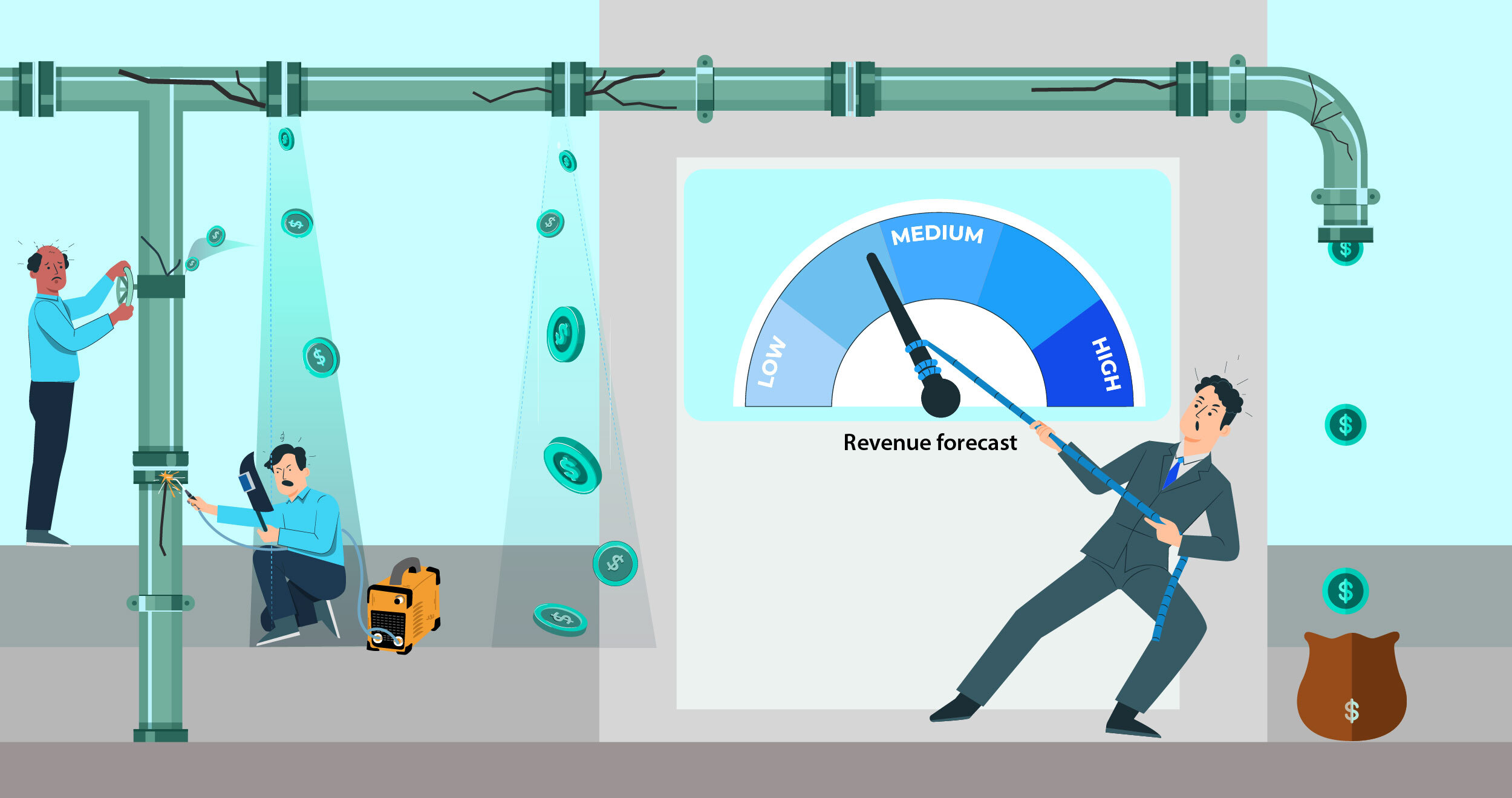Why Revenue Leaks Occur And How To Ensure Accurate Forecasts
Explore the causes of revenue leakage and learn effective strategies to prevent it, ensuring precise forecasts for sustainable business growth.
Table of Contents


Why Revenue Leakage Happen and How to Prevent Them for Accurate Forecasts
A revenue forecast entails projecting the anticipated income for a specific timeframe, typically on a quarterly or annual basis. This forecast involves consideration of various factors and data points, such as past financial performance, historical data, sales pipelines, and market sentiment. Essentially, it serves as an informed estimate of the anticipated financial inflow for the upcoming quarter or year. This forecast is instrumental in determining budgetary allocations, assessing profit margins, and making informed decisions related to staffing and production. Accuracy in revenue forecasting is paramount, as relying on inaccurate predictions can lead to misguided business decisions.
Importance of Revenue Forecasting
Revenue forecasting holds a foundational role in business and sales strategy, providing a crucial basis for informed decision-making regarding financial planning and budgeting. Its applicability spans diverse industries and company sizes, offering several advantages. This is valuable despite the inherent estimation involved, as it offers a more informed range of financial guidelines.
Additionally, revenue forecasting enables businesses to predict hiring capacity by understanding expenditure capabilities, facilitating informed decisions about team expansion based on current financial standings and potential growth. Accurate revenue forecasting also aids in setting sales compensation goals, serving as a foundational tool for structuring bonus tiers, sales quotas, and targets for the sales team.
Furthermore, it plays a pivotal role in facilitating scaling of the business by predicting income growth based on anticipated changes and economic conditions. This helps guide businesses in formulating their growth strategy in a way that aligns with production capacity and market dynamics. Hence, revenue forecasting is indispensable for informed decision-making, guiding businesses in financial planning, team management, goal-setting, and strategic scaling.
How Prevalent are Misses in Revenue forecasting?
Revenue leaks in revenue forecasting are a common concern across organizations and can result from factors such as inaccurate data, ill-defined or ineffective sales, marketing and CS processes, non-compliance with standard GTM processes, cross-functional inefficiencies, changes in market conditions, technology issues, and human error.
The prevalence of revenue leaks varies based on industry, company size, and maturity of internal GTM processes. To address this issue, organizations should prioritize data accuracy, foster collaboration between sales, marketing, and CS teams, optimize GTM processes, stay informed about market dynamics, invest in technology, and provide training to reduce human errors. Regular reviews of internal processes in conjunction with forecasting methods are essential to identify and rectify potential issues before they impact revenue. Mitigating revenue leaks requires a comprehensive approach that considers various aspects of data management, communication, and process optimization.
How to Plug Revenue Leakage to Close Your Revenue Forecast Gap
To address revenue leakage and close the revenue forecast gap, consider the following strategies:
Ensure Data Hygiene and Accuracy
Poor data quality and accuracy is an issue that plagues most companies. Whether they choose to tackle it immediately or kick the can down the proverbial line is what differentiates the have-visibility from the have-nots. In the case of organizations with bad data, manual \ cleanup will be required before any analysis can be done which will mean delays and inaccuracies along the way. The use of products and/or services that help with data cleanup and implement data hygiene can provide noteworthy time savings for revenue operations teams on a weekly basis, concurrently elevating the accuracy of forecasts.
Operationalize Regular Market Research
Insufficient market research negatively affects revenue forecasting by leading to inaccurate demand estimations, misdirected marketing tactics and other GTM gaffes, and an inability to identify and adapt to market trends. This shortfall in understanding can result in poor decision making, leading to a competitive disadvantage, poor resource allocation, and unrealistic sales forecast. Businesses may also face a higher risk of product failure, as the lack of comprehensive research can lead to the development of products that do not resonate with the target market. Overall, robust and ongoing market research is crucial for businesses to make informed decisions, align with market dynamics, and accurately forecast revenue.
Fix Ill-Defined or Ineffective Sales Processes
Ineffective sales processes can undermine revenue forecasting by introducing inaccuracies and uncertainties. Issues such as inconsistent updates to the CRM, lack of compliance with defined sales practices, too many variances in sales behavior across reps, prolonged sales cycles due to poor sales cadence, inability to respond to changing customer needs or lack of awareness of market conditions, can all disrupt the accuracy of revenue forecasting. To address these issues and close revenue forecast gaps, it is crucial to maintain a well-defined sales process aligned with specific stages in the sales funnel. These stages, intricately linked to the buyer’s journey, should be meticulously documented for a shared understanding of how leads are counted upon entering or leaving the funnel. Clearly outlining the procedural steps for converting a lead into a customer and explicitly defining criteria for qualifying leads, opportunities, prospects, and closures is essential. Failure to communicate and standardize these criteria may lead to individual team members interpreting sales process stages differently, resulting in data inconsistencies that undermine the accurate prediction of opportunity closures.
Improve Cross-functional Collaboration
Siloed mindset, lack of trust between departments and misalignment of goals and priorities are standard organizational impediments that come in the way of efficient revenue generation. To address revenue leakage through poor cross-functional collaboration, organizations can implement several key strategies. A prerequisite first step is to bring previously isolated functions together not just in name but also in cause under a single revenue organization. Establishing a common set of KPIs and building transparent communication channels helps breaks down silos and can help foster a collaborative culture across groups. In addition, it is also vital to create a single-pane-of-glass level of visibility of the overall revenue engine for everyone. Often, this will require a technology solution to close data silos and enable cross-functional analytics. These measures can foster effective cross-functional collaboration and plug revenue leakage.
Improve Sales Training and Rep Ramp-up
Establishing a systematic onboarding procedure helps expedite the integration of new sales hires. Revenue Operations plays a crucial role in delivering consistent training and coaching to sales teams, enabling them to cultivate market-specific skills and remain abreast of the latest industry trends and best practices. RevOps can achieve this by pinpointing deficiencies in the sales team’s skills and knowledge, crafting and implementing targeted training programs to fill these gaps, and equipping sales teams with valuable sales enablement tools like playbooks, case studies, and instructional videos.A key insight is understanding what granular sales processes are followed by the top selling reps that are missed by the others, and delivering customized coaching to close that gap.
Facilitate Agile Response to RevOps Deviations
Cultivate a proactive approach to address deviations in key metrics by fostering agility within RevOps teams. This agility enhances the achievement of vital key performance indicators (KPIs), including win rate, sales cycle, ACV, cost of customer acquisition, retention rate, pipeline velocity, and more. Implement real-time monitoring systems, establish clear protocols for early discovery of unexpected changes, and empower teams to make prompt and informed decisions to adapt to evolving circumstances.
By strategically addressing these areas, businesses can strengthen the foundation of their revenue engine thereby minimizing revenue leakage and improving their revenue forecasting abilities along the way.
Limitations of forecasting tools
The limitation of forecasting tools is highlighted by their failure to encompass the end-to-end perspective, extending from marketing to customer success. This gap in coverage prevents a comprehensive understanding of the entire customer journey and may result in erroneous forecasts. To address this limitation, organizations should seek integrated forecasting tools that consider the full spectrum of customer interactions, ensuring a more accurate and holistic prediction of outcomes across the entire business cycle.
Forecasting tools, such as Clari, Boostup, Aviso, etc. may predict future outcomes but often fall short in providing the detailed insights into the contributing factors or the “why” behind the revenue leakage that causes a drop in forecast. Considering they don’t know why the forecast is falling short, they also cannot recommend suitable remedial actions to bring the organization back on track.
Emerging technologies in revenue intelligence can help provide this added visibility. By leveraging AI/ML models and advanced data visualization, they can improve the visibility of the overall revenue engine, thereby plugging revenue leaks and improving the accuracy and efficiency of revenue forecasting processes.
BigLittle helps you forecast potential dips in your Revenue Performance
At BigLittle, we are helping define and build this future of RevOps. We are the Revenue Optimization layer for RevOps teams. Our product Biglittle RevenUp allows revenue leaders to better understand the inner workings of their overall GTM engine across marketing, sales and CS, identify potential risks and growth opportunities, and analyze cross-functional data on demand to facilitate more accurate revenue forecasts.
Get in touch with us today!



